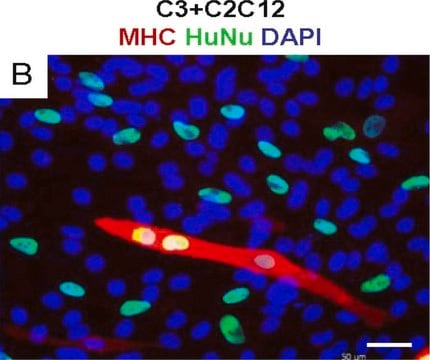MAB1276
Anti-Nuclei & Chromosomes Antibody, histone H1 protein, clone 1415-1
clone 1415-1, Chemicon®, from mouse
Synonym(s):
Anti-H1.4, Anti-H1E, Anti-H1F4, Anti-H1s-4, Anti-HIST1H1E, Anti-RMNS, Anti-dJ221C16.5
About This Item
Recommended Products
biological source
mouse
Quality Level
antibody form
purified antibody
antibody product type
primary antibodies
clone
1415-1, monoclonal
species reactivity
human, rat
manufacturer/tradename
Chemicon®
technique(s)
ELISA: suitable
immunocytochemistry: suitable
immunohistochemistry: suitable (paraffin)
western blot: suitable
isotype
IgG2a
NCBI accession no.
UniProt accession no.
shipped in
wet ice
target post-translational modification
unmodified
Gene Information
human ... H1-1(3024)
Specificity
Stains nuclei of all human cell types and also stains chromosomes diffusely in metaphase cells. Nuclear staining in interphase cells is intense and diffuse. Antibody reacts with rat cells {Bendeck, 2001}.
Immunogen
Application
Physical form
Analysis Note
POSITIVE CONTROL:
Human tonsil
Legal Information
Not finding the right product?
Try our Product Selector Tool.
Storage Class Code
12 - Non Combustible Liquids
WGK
WGK 2
Flash Point(F)
Not applicable
Flash Point(C)
Not applicable
Certificates of Analysis (COA)
Search for Certificates of Analysis (COA) by entering the products Lot/Batch Number. Lot and Batch Numbers can be found on a product’s label following the words ‘Lot’ or ‘Batch’.
Already Own This Product?
Find documentation for the products that you have recently purchased in the Document Library.
Our team of scientists has experience in all areas of research including Life Science, Material Science, Chemical Synthesis, Chromatography, Analytical and many others.
Contact Technical Service







